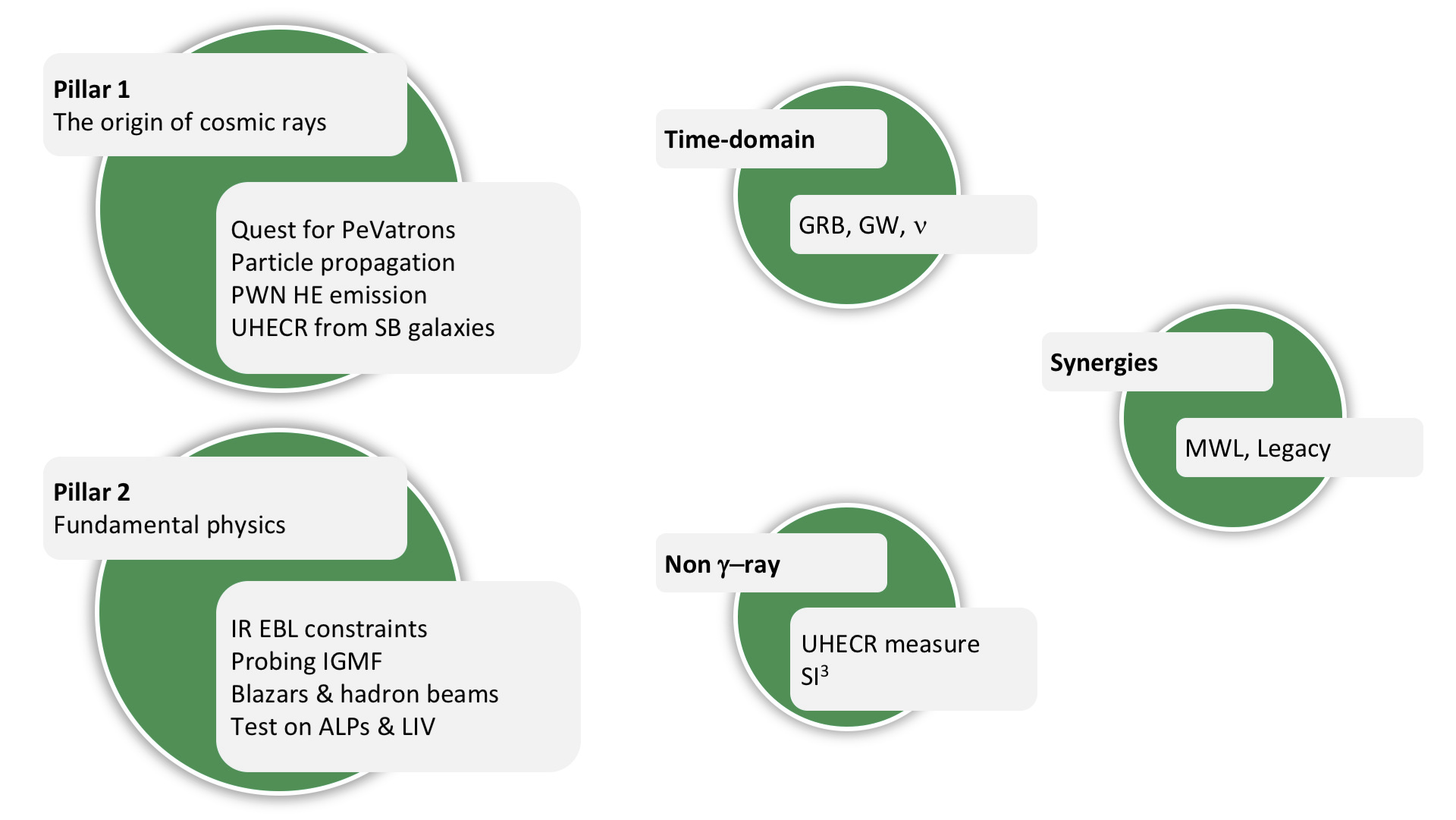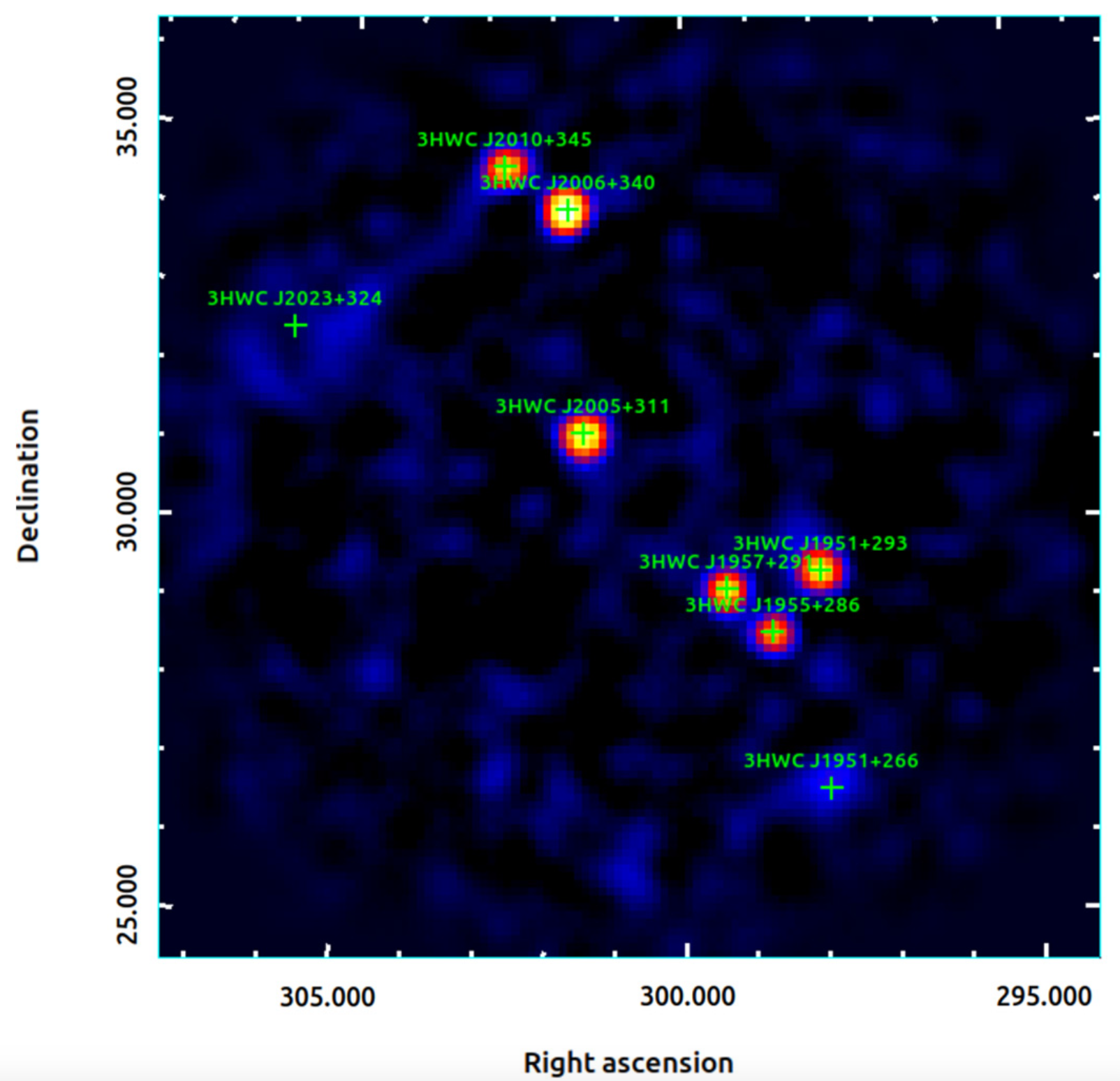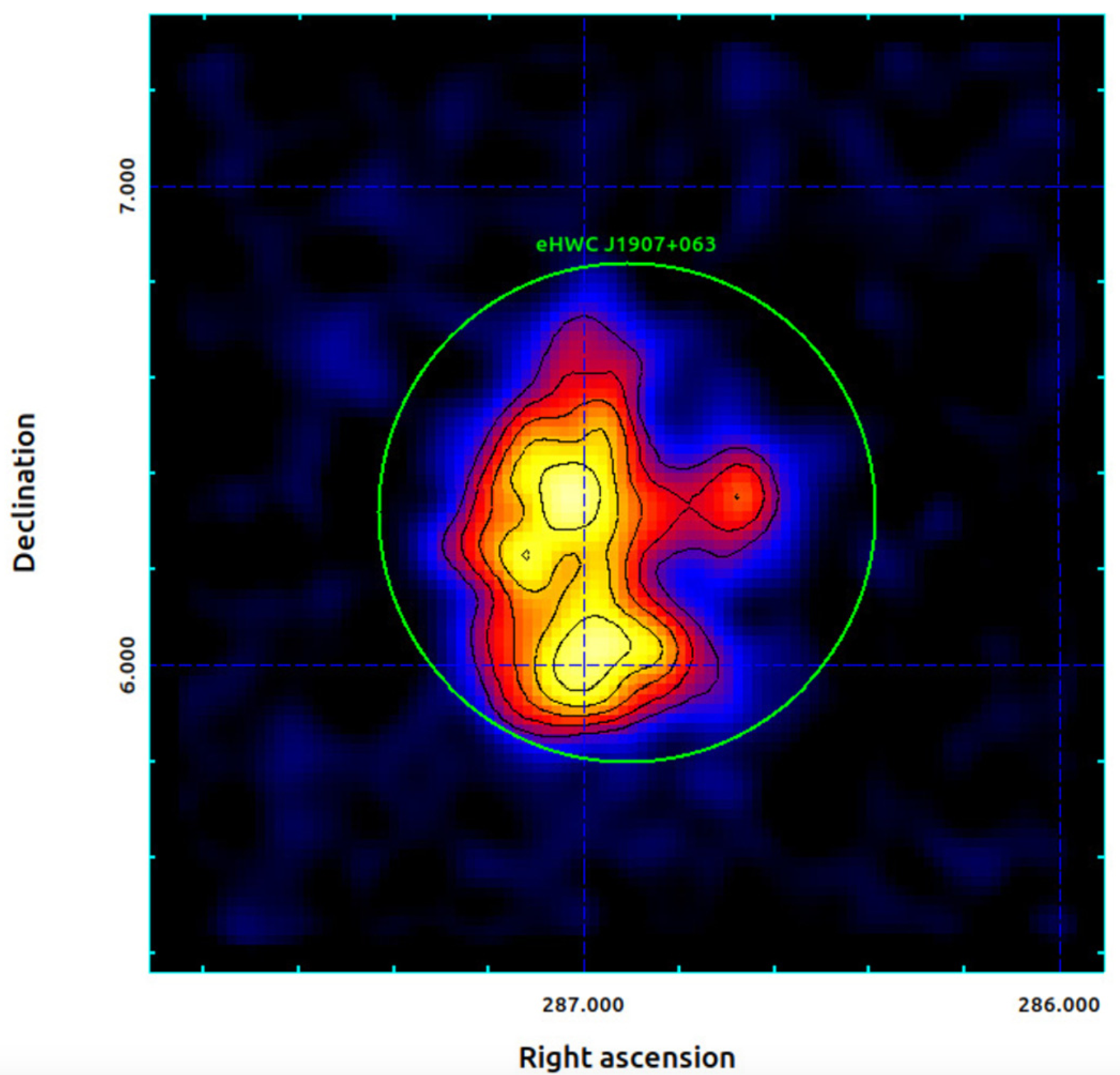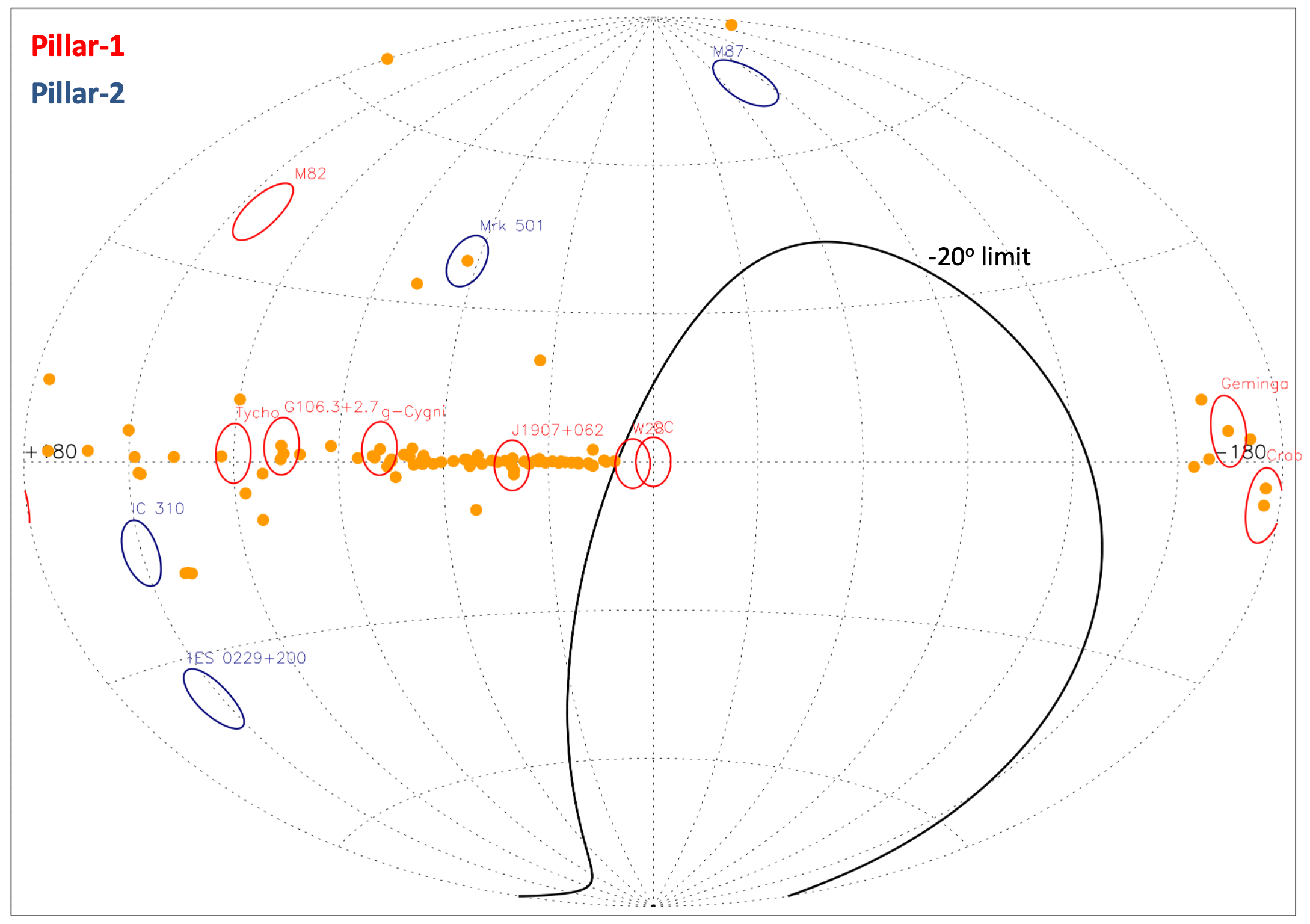ASTRI Mini-Array Science
The “ASTRI Pillars”
The ASTRI Mini-Array science program will develop in two phases. During the first four years of operations, the ASTRI Mini-Array will be run as an experiment, while in the subsequent four years, it will gradually evolve into an observatory open to the scientific community. A graphical description of the main Core Science topics that we plan to investigate during the first four years of operations is shown in the following Figure.
Our Core Science Program is based on “Main Pillars”. They are science fields in which the ASTRI Mini-Array will contribute breakthrough pieces of evidence to improve our understanding of a few key science questions.
The ASTRI Mini-Array will investigate VHE and UHE sources, providing both the opportunity for their precise identification and important information on their morphology and spectra.
The ASTRI Assets
The wide energy range.
For the first time, we extend current IACTs differential sensitivity up to several tens of TeV and beyond. This will allow us to investigate possible spectral features at VHE, such as the presence of spectral cut-offs or the detection of emission at several tens of TeV expected from Galactic PeV sources.
The large field of view.
The ASTRI Mini-Array 10° field of view, in conjunction with excellent off-axis performance (only a factor of two less sensitive at the border of the FoV than on-axis), will allow us to simultaneously investigate multiple targets in a single pointing and to facilitate the possibility of serendipitous discoveries.
This Figure shows the importance of a wide field of view when pointing crowded regions. The panel reports the 200 hr simulation of a deep pointing towards the Cygnus Region. Several sources of the Third HAWC Catalog of Very-high-energy Gamma-Ray Sources (3HWC) can be observed and possibly detected in a single pointing by the ASTRI Mini-Array. Green crosses mark the positions of the 3HWC sources in a 10°×10° field of view [Credits: Vercellone S. et al., 2022, JHEAP, 35,1]
The optimal angular resolution.
The ASTRI Mini-Array has an angular resolution of about 3’ in the energy range 3–100 TeV.
This Figure highlights the importance of the ASTRI Mini-Array angular resolution. The image shows the ASTRI Mini-Array 200 hr simulation (for energy up to 200 TeV) of the region around the Galactic source eHWC 1907+063. The light green circle marks the ∼0.52° HAWC error-box (for E > 56 TeV). Although the ASTRI Mini-Array and HAWC have a similar energy range, their angular resolution is remarkably different. The ASTRI Mini-Array will easily resolve Galactic sources emitting at UHE despite their large error boxes. [Credits: Vercellone S. et al., 2022, JHEAP, 35,1]
ASTRI Mini-Array and UHE Observatories
We foresee important synergies with current UHE facilities such as LHAASO, HAWC, and Tibet AS-𝞬. An example of such synergies is illustrated in the following Figure, where we show Pillar-1 and Pillar-2 target regions (red and blue circles, ≈10o in diameter) and 1LHAASO (Cao et al, 2024, ApJS, 271, 25) sources (orange dots) on the sky in Galactic coordinates (Aitoff projection). The black solid line shows the declination limit for the ASTRI Mini-Array pointings.
Some 1LHAASO sources already overlap the ASTRI Mini-Array selected Pillar regions, in particular along the Galactic Plane. We also note that Mrk 501 and Mrk 421 are natural candidates for common variability studies.
ASTRI Mini-Array Simulation Tools
The ASTRI Mini-Array scientific simulations are based on the current instrument response function files (IRFs, Prod2, v1.0) which are available on Zenodo.
The IRFs are saved in a FITS data file which contain the following quantities (FITS tables): effective collection area (“EFFECTIVE AREA” table), angular resolution (“POINT SPREAD FUNCTION” table), energy resolution (“ENERGY DISPERSION” table), and residual background rate (“BACKGROUND” table). These quantities are provided as a function of the energy and the off-axis angle. The energy bins are logarithmic and range between 10-0.7 ~ 0.2 TeV and 102.5 ~ 316 TeV. Five energy bins per decade are used for the angular resolution and residual background rate, while ten energy bins per decade for the effective collection area. For the energy resolution, the energy migration matrix is provided with a much finer energy binning. The off-axis angle bins are linearly spaced between 0° and 6°, with a bin width equal to 1°. In the case of the residual background rate, a 2-dimensional squared spatial binning is used, which ranges between 0° and 6° with a bin width equal to 0.2° in each direction.
The IRFs can be used as input to science analysis tools and, in particular, are compliant with the input/output (I/O) data format requested by the science analysis tools Gammapy [Donath A., et al., 2023, A&A, 678, A157] and ctools [Knödlseder J., et al., 2016, A&A 593, A1].
The main ASTRI Mini-Array performance are summarized in Performance of the ASTRI Mini-Array at the Observatorio del Teide – Lombardi S, et al., 2022, PoS(ICRC2021), 884
ASTRI Mini-Array General Science Papers
The most recent refereed papers describing the ASTRI Mini-Array science topics are:
- Science with the ASTRI Mini-Array: From Experiment to Open Observatory – Vercellone S., for the ASTRI Project, 2024, Universe, 10, 94
- ASTRI Mini-Array core science at the Observatorio del Teide – Vercellone S., et al., 2022, JHEAP, 35, 1
- Extragalactic observatory science with the ASTRI mini-array at the Observatorio del Teide – Saturni F.G., et al., 2022, JHEAP, 35, 91
- Galactic observatory science with the ASTRI Mini-Array at the Observatorio del Teide – D’Aì A., et al., 2022, JHEAP, 35, 139
Some useful links to current [upcoming] MWL facilities
- Radio: ALMA, ASCAP, Chime, FAST, INAF Radio Telescopes, LOFAR, MeerKAT, [SKAO]
- Optical: [ELT], GTC, Liverpool Robotic Telescope, NTT, REM, TNG, Vera C. Rubin Observatory, VLT, WEBT
- X-Ray: Chandra, Einstein Probe, eROSITA/SRG, HERMES, Insight-HXMT, IXPE, NuSTAR, XMM-Newton, SVOM, Swift, XRISM
- HE: [COSI], Fermi
- VHE: [CTAO], H.E.S.S., LST-1, MAGIC, VERITAS
- UHE: HAWC, LHAASO, [SWGO], Tibet AS-𝞬
- Cosmic Rays: Pierre Auger Observatory
- Neutrino: ANTARES, IceCube, KM3NeT
- Gravitational Waves: LIGO, KAGRA, VIRGO
This post is also available in: Italian




